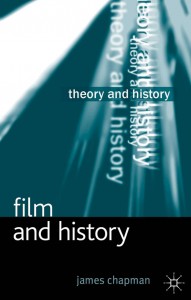Film and History by James Chapman (Palgrave Macmillan, 2013). 192 pages. ISBN: 978-0230363861 (hardback), £ 55; ISBN: 97800230363878 (paperback), £17.99
 About the reviewer: Dr Keith M. Johnston is Senior Lecturer in Film, Television and Media Studies at the University of East Anglia, with specific interest in film trailers, 3D media, film genre and British cinema. He studied for his BA in Film & Media Studies at the University of Stirling and the University of California Santa Barbara; and received his MA and PhD from the University of Kent. His publications include Coming Soon: Film Trailers and the Selling of Hollywood Technology (2009); Science Fiction Film: A Critical Introduction (2011).
About the reviewer: Dr Keith M. Johnston is Senior Lecturer in Film, Television and Media Studies at the University of East Anglia, with specific interest in film trailers, 3D media, film genre and British cinema. He studied for his BA in Film & Media Studies at the University of Stirling and the University of California Santa Barbara; and received his MA and PhD from the University of Kent. His publications include Coming Soon: Film Trailers and the Selling of Hollywood Technology (2009); Science Fiction Film: A Critical Introduction (2011).
This brief but comprehensive overview of film history as both discipline and subject matter offers a solid introduction to topics first covered in Robert Allen & Douglas Gomery’s reowned Film History: Theory and Practice (New York: McGraw-Hill, 1985). Chapman acknowledges the debt that media history scholars owe to that book, and those authors, and necessarily covers many of the same debates and issues. However, it also usefully expands those areas into newer case studies and areas like Third Cinema, or British audience studies, offering different ways to approach existing debates. Indeed, the fourth chapter, on ‘Film as a Historical Source’ is an important expansion from Allen & Gomery, and considers the different roles that a film can play: as historical record, ideological project, propaganda, entertainment, and/or art form. This chapter also usefully considers the role of the historical reconstruction (such as The Private Life of Henry VIII [1933] or Lady Hamilton [1941]) and the inscription of the social and political of the period of production, not the historical period being recreated.
In collecting and collating this range of examples and theories, the book operates as a history of film studies as much as  a study of film history, with Chapman demonstrating how the ‘historical turn’ in film studies emerged from other theoretical debates and ideas. He carefully traces historical arguments around realist and formative traditions in film aesthetics, the rise of auteur and genre theories, ideological approaches, structuralism, and others. The restrictive length imposed by the format of the book series means Chapman can only offer brief summaries of these approaches, but on the whole they function as potent overviews, and point out recurring absences around, for example, audience research, historical rigour, and non-Western examples. As in all great ‘historical epics’, students and established scholars will find a cast of well-known names (Bazin, Bordwell, Eisenstein, Deleuze, Durgnat, Kracauer, Mulvey, Sarris, Thompson) and canonical films (Arrival of a Train at La Ciotat [1895], The Battleship Potemkin [1927], The Wizard of Oz [1939], Citizen Kane [1941]).
a study of film history, with Chapman demonstrating how the ‘historical turn’ in film studies emerged from other theoretical debates and ideas. He carefully traces historical arguments around realist and formative traditions in film aesthetics, the rise of auteur and genre theories, ideological approaches, structuralism, and others. The restrictive length imposed by the format of the book series means Chapman can only offer brief summaries of these approaches, but on the whole they function as potent overviews, and point out recurring absences around, for example, audience research, historical rigour, and non-Western examples. As in all great ‘historical epics’, students and established scholars will find a cast of well-known names (Bazin, Bordwell, Eisenstein, Deleuze, Durgnat, Kracauer, Mulvey, Sarris, Thompson) and canonical films (Arrival of a Train at La Ciotat [1895], The Battleship Potemkin [1927], The Wizard of Oz [1939], Citizen Kane [1941]).
The book’s underlying ideological principle is to argue for the importance of social and historical context and to point out its absence across a range of other theoretical approaches, not least ‘Screen theory’, classic auteur theory (or the ‘unreconstructed auterist’ approach offered by Deleuze) and the historical poetics championed by David Bordwell. Chapman’s coverage is never dismissive, but he offers a range of evidence that supports his wider point that contextual work can address wider social, industrial, technological or ideological questions than the ‘aesthetic histories… [that] account for the majority of film histories.’ (53) This is most clearly articulated in the sixth chapter ‘A Historical Sociology of Film’ which departs from textual analysis to consider histories of production, exhibition, reception, and audiences. Crucially for the book’s overall argument, such histories function as a challenge to the more traditional and embedded approaches such as auteurist or ‘Screen theory’ found elsewhere in the history of film studies. While Chapman’s conclusion – that analysis of film texts should work alongside historical contextual analysis – is hardly revolutionary, it is worth stressing to the newer media historians who make up the book’s likely target audience.
Given that audience, and the compelling case made for more in-depth historical work, it is unfortunate that the book lacks any basic ‘how to’ guide for historical analysis. That may be beyond the scope of ‘Theory and History’ book series (to which Film and History belongs), but it remains a lost opportunity to step outside of the history being covered and encourage others to develop their own skills.
Dr Keith M. Johnston